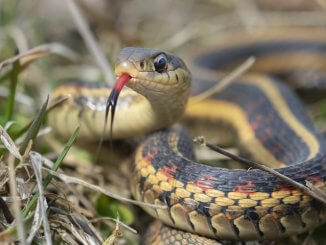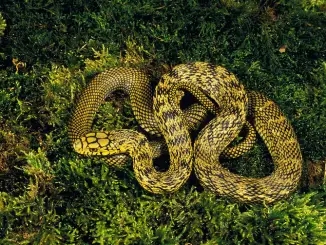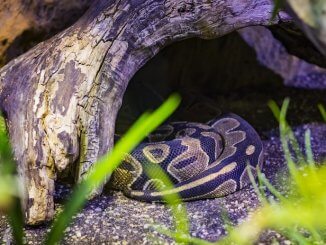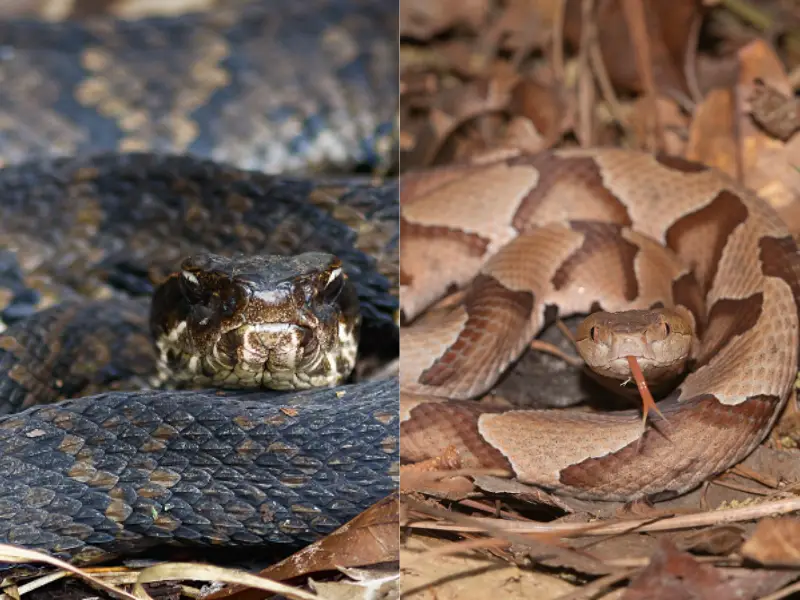
It can be easy to confuse different reptiles in the wild. Especially with venomous snakes, it’s important to learn some basic differences between certain species in case they’re ever encountered.
Cottonmouth and copperhead are two commonly confused species of North American snakes with several similarities and distinctions. Becoming familiar with the characteristics of each can be extremely useful in identifying these reptiles.
At a glance, determining which serpent just slithered by can be challenging. However, when you know what traits to watch out for, it’s much easier to quickly determine which type of snake has been sighted.
Here, we’ll break down everything there is to know about cottonmouths and copperheads, including what they share and what sets them apart.
Cottonmouth vs. Copperhead: Why It Matters
Cottonmouth and copperhead snakes belong to the same genus, Agkistrodon, but they are different species with unique qualities, both physically and behaviorally. Knowing what sets the two apart is important, as some of their features can be dangerous, even fatal.
Avoiding wild snake contact is always wise, but accidents happen. Preparedness is key in responding to snake bites, so knowing what to expect can better prepare you for an emergency situation.
Following any snake bite, it’s strongly advised to take a photo of the animal, then seek help immediately. A clear image aids significantly in identifying the type of venom and the appropriate course of action. The effectiveness of antivenom interventions is greatly improved with accurate identification of the specific toxin being treated.
Residents and medical professionals in states that are home to one or both species should be especially aware of their shared and unique characteristics to remain alert and avoid any excess risk of unwanted contact with harmful snakes.
There are many shared and distinct qualities among copperheads and cottonmouths, and it’s vital to understand the difference between these two reptiles because, in the worst-case scenario, knowing the difference can be a literal lifesaver.
About Cottonmouth Snakes
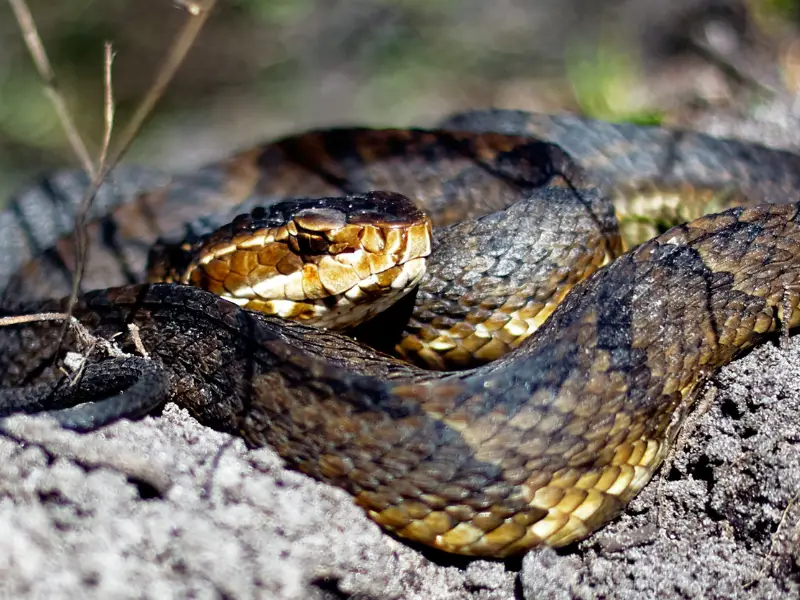
Cottonmouth snakes are named for the pronounced white color of their mouth’s interior. If confronted, they’ll open their mouths wide in an attack stance but generally prefer to avoid human contact. They’re not known to be aggressive, but the venom from their bite is highly toxic and requires immediate medical attention.
Cottonmouths are more vibrant when young, but their color fades and darkens with age. They start life as short as 5 inches and grow up to 4 feet long. Prone to swampy regions like marshes and lakeside trees, cottonmouths have an estimated lifespan of roughly 10 years.
They are solitary, nocturnal reptiles with a distinctive stripe across the eye line of their faces. Their bodies and heads are brown, tan, yellowish, or sometimes include darker shades closer to black. They feature a splotched pattern, although sometimes dark cottonmouth snakes can appear banded or solid.
Native to the southeastern United States, cottonmouths are fond of wetlands, especially in Texas and Florida. Sometimes called “water moccasins” for their crossband of color and affinity for water, the cottonmouth is North America’s most venomous snake.
About Copperhead Snakes
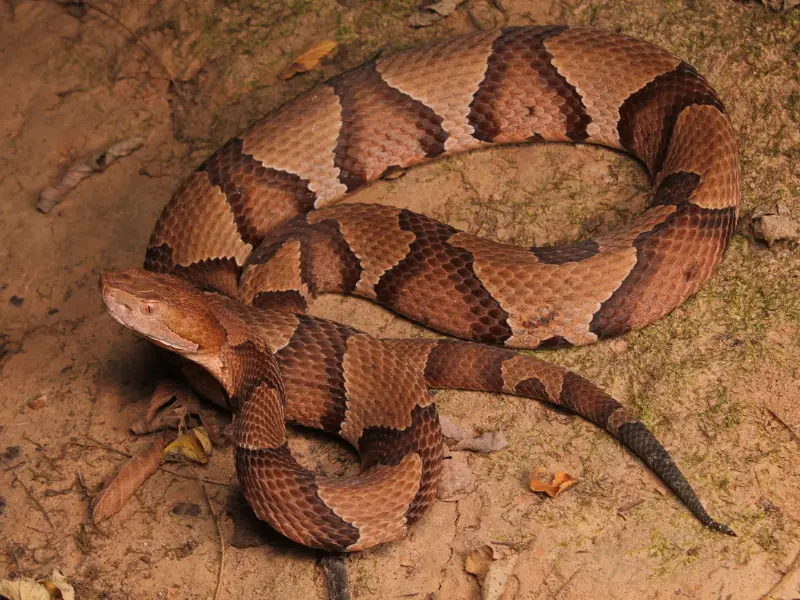
Copperhead snakes are named for the reddish color of their heads. These triangular, copper-capped snakes have tan or brown bodies covered with dark, hourglass-shaped crossbands and can also feature yellow and olive-black shades.
Copperheads like dry regions and prefer areas like woods, mountains, and rocky canyons. Their bright coloration is retained throughout life, and red-colored heads are a distinctive feature of these non-lethal snakes.
The copperhead snake, at its smallest and largest, is not dissimilar from the cottonmouth. They both range from 3-4 feet fully grown, but the two snake species have different body types. Although copperheads are more easily confused with young cottonmouths, they are generally smaller and slimmer.
Copperhead snakes can live roughly 18-25 years. They’re found from northern Mexico to southern New England, encompassing much of the southern United States that are native to cottonmouths.
Cottonmouth vs. Copperhead: Physical Features
When examining cottonmouth vs. copperhead snakes, the most immediately apparent distinguishing features are visual. Most notably, their body types, shapes, and colors set these snakes apart.
When discerning cottonmouths vs. copperheads, remember they’re each named for a pronounced physical feature: white mouths and copper-colored heads, respectively. If these traits aren’t obvious, there are several other ways to distinguish each snake.
Cottonmouths feature an eye-level face stripe that sets them apart from their red-headed cousins. Despite their sometimes shared color palette, cottonmouths are duller and darker than copperheads, and their heads match their bodies. Copperheads retain a sharp, lifelong pattern, while cottonmouths darken and fade with age.
Copperheads’ mouths are pink inside; cottonmouths are white. Cottonmouths usually grow longer, thicker bodies than copperheads, but age is an important factor when comparing each snake’s size.
Another surefire way to tell which snake is which: copperheads have round pupils, but the pupils of highly venomous cottonmouths are thin and slit-shaped.
Cottonmouth vs. Copperhead: Behavior
Cottonmouths and copperheads share some behavioral traits, but others are distinct. During mating season, for instance, both breeds’ males are more aggressive towards one another in competition for females. Also, both snakes are nocturnal.
Cottonmouths hunt at night, prefer to be left alone and don’t attack humans unprovoked. Unfortunately, accidentally crossing paths with one can be a deadly encounter, even for healthy adults. Their bites aren’t especially common, and they’ll usually display other defenses before biting, like mimicking a rattlesnake’s shaking tail and exposing fearsome fangs.
Copperheads are landbound, but cottonmouths have adapted to possess semi-aquatic abilities, meaning they move easily both in water and on land. Both snakes are technically venomous, but copperhead bites are far less dangerous.
Neither type of snake is particularly aggressive but always try to avoid contact with them in nature, as wild animals will instinctively respond whenever they feel threatened.
Cottonmouths vs. Copperheads: Habitat
Despite sharing several home states from Virginia to Texas, these two snakes are unique in the environments they seek out. Generally, cottonmouths are more avoidant of humans than copperheads.
Copperheads enjoy rocky, wooded, and mountainous zones and are also known to wander into developed areas like suburbs and construction zones to seek shelter under large objects. They prefer dry conditions and lack aquatic abilities.
Cottonmouths are normally found near swamps, lakes, rivers, and marshes but will stray when they dry up. They’re most active at night, but they also spend time sunbathing on warm surfaces or climbing high trees near the waterline. They like humid, wet conditions and are especially populous in Florida and Texas.
Cottonmouth vs. Copperhead: Diet
Both of these carnivorous snakes are nocturnal and primarily hunt at night. However, the diet of copperheads is not as varied as that of cottonmouths, and each snake species uses specific techniques to catch its prey.
To attract their prey, Copperheads will sometimes strategically move their tails to patiently lure small animals close enough to attack easily. They employ and depend on various techniques to hunt effectively, such as their innate ability to locate warm-blooded animals.
To detect their prey, copperhead snakes are equipped with special face indentations located between their nose and eyes. This unique biological feature allows them to locate the small, active animals they frequently hunt in the dark.
The cottonmouth’s prey features a wider variety than that of copperheads, especially since they can hunt in water. Cottonmouths eat many of the small rodents and reptiles that copperheads do, plus other animals like birds, fish, and other snakes, including cottonmouths. They’ll even eat dead animals.
Cottonmouths rely on their natural camouflage and toxic venom to hunt, sometimes tracking larger animals post-bite, waiting for them to succumb to the injury. Cottonmouths have a strong, steady appetite, which fuels their rapid growth rate and multi-annual skin shedding.
Cottonmouth vs. Copperhead: Life Cycle
Typically, males of both cottonmouth and copperhead snakes are markedly more aggressive towards one another while competing for females during the mating season in spring. They will frequently fight one another to gain a mate, and copperhead male competition can be slightly more fierce.
Both species birth live snakes, often in large numbers, although it’s unclear what factors determine the number of baby snakes in each birth. Copperheads can be born more than 10 at a time, then remain with their parents for a while before setting off on their own.
Cottonmouths are born in groups of up to 20. Following birth, cottonmouth offspring are quick to seek independence from their parents. This makes it somewhat difficult to accurately discern their lifespan, but they are believed to live only about half as long as copperheads.
Cottonmouths have another mating season in the fall, and copperheads can also mate again at this time. Then, during the colder months, both snakes seek warmth and shelter, ultimately hibernating through the winter.
Copperheads normally retreat underground. They’re socially capable, with a tendency to share burrow spaces with other species. Cottonmouths also take shelter underground or beneath large rocks during winter but are more likely to independently use abandoned subterranean spaces.
Cottonmouth vs Copperhead: Defenses
Both cottonmouth and copperhead snakes can be dangerous when threatened. Cottonmouth bites are significantly more severe, but there are other defenses each snake will resort to first.
Cottonmouths sometimes bear their white-gummed fangs in a wide-mouthed attack stance or imitate rattlesnakes by shaking their tails. Cottonmouths also emit a foul odor from the musk gland as a natural defense mechanism to ward off predators.
Copperheads are known to feign death to avoid predators and humans. They’ll often stay immobilized until the threat has passed.
Cottonmouth vs. Copperhead: Bite & Venom
Comparing the bites of cottonmouth vs. copperhead snakes, both are venomous, but they require different treatments. Medical treatment isn’t always necessary for minor copperhead bites, but medical intervention is a necessity with cottonmouth bites. This makes distinguishing them especially imperative for pursuing the correct form of treatment.
The toxicity of cottonmouth snake venom is much higher than copperheads. Even in healthy adults, cottonmouth bites can be deadly and should always be treated as a serious, urgent situation.
The highly toxic venom of cottonmouths is thought to act on mammals’ blood coagulation process by attacking red blood cells, and it’s not uncommon for bite victims to suffer breathing difficulties. There will also usually be inflammation and skin discoloration at the site. Recovery is likely with prompt treatment. Almost 10,000 people sustain cottonmouth bites annually in the US, but only a handful are fatal.
Copperhead snake bites do contain venom, but they are not life-threatening to adults in good health. However, for seniors and small children, large amounts of copperhead venom can be much more dangerous.
Despite their less severe bites, copperheads are more often aggressive toward humans. Copperheads bite with extreme force, causing bruising, severe pain, and sometimes difficulty breathing. These bites are also characterized by a distinctly metallic taste on the victim’s tongue.
Even when they’re less harmful or serious, all snake bites are frightening, painful experiences that we all hope to avoid. Symptoms can set in within minutes or take up to hours, so identifying the snake to swiftly determine and administer proper treatment is essential.
Discerning the identity of the snake is crucial to treating a bite correctly. Either way, it’s always safest to seek immediate medical attention in the incidence of a snake bite.
Cottonmouth vs. Copperhead: Key Distinctions
Cottonmouths and copperheads are two multicolored, earth-toned snakes that exist in many of the same southern US regions. They’re nocturnal, carnivorous, and can possibly bite when threatened, although neither is typically aggressive.
Cottonmouths live around 10 years, and copperheads can reach about 20. Both snakes reach 3-4 feet when fully grown, but the average copperhead is slightly smaller and slimmer than cottonmouth adults.
Copperhead tails are narrower at the end, and their reddish (copper) heads stand out from their brown, yellow, and olive-black patterned bodies. Cottonmouths (fittingly) have white mouths, as well as slit-shaped pupils and a stripe across their eyes.
Even in old age, copperheads remain vibrantly colored with an intricate design of hourglass-shaped stripes. Cottonmouths’ splotchy, solid, or banded colors are bright when young, then fade and darken over time.
Both types of snakes are found in the southern US. Copperhead populations reach from northern Mexico to southern New England, where they normally seek out rocky, dry areas, like canyons or construction sites.
Slightly longer, wider-bodied cottonmouths are native to the southeastern US, from Florida to Texas, where they gravitate to wet zones like lakes, rivers, marshes, and swamps.
Copperheads are more social, while cottonmouths are more solitary. Copperheads are more confrontational, but cottonmouths can be much more dangerous.
Wrap Up
Comparing copperheads vs. cottonmouths includes evaluating their physical features, behaviors, and life cycle characteristics. Discerning between the two snakes is essential, as they can be dangerous when threatened.
Semi-aquatic, marshland-loving cottonmouths are more capable, eat a more diverse diet, and possess a more lethal bite but are less likely to use it.
Hourglass-patterned, red-headed copperheads are prone to rocky and wooded areas but are less afraid of wandering into human-populated spaces. They have a painful but non-lethal bite.
Aggression levels towards people are low in both snakes, and they’re each more likely to fight their own kind during mating seasons. Like most small wild animals, they prefer to avoid unwanted run-ins, and neither of these serpents would make a good pet.
These snakes hibernate in winter and hunt at night; they likely hope you don’t stumble across them even more than you. If you happen to encounter one, respect its space and, if possible, safely observe the key differences that assure you of its species and threat level.
These two snakes are commonly confused and misidentified, especially when they’re young, so always practice caution. If a snake bite occurs, photograph the animal and seek help immediately.
Knowing what to look for is key to telling cottonmouths vs. copperheads apart. Regardless of which snake is identified, they’re both best left alone.

